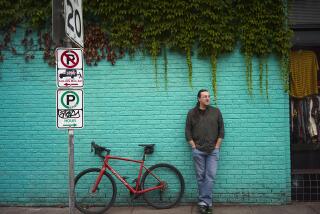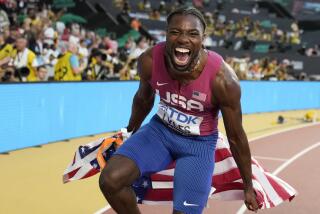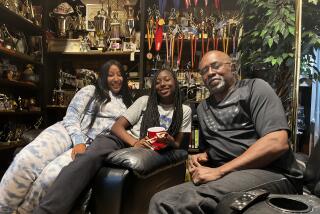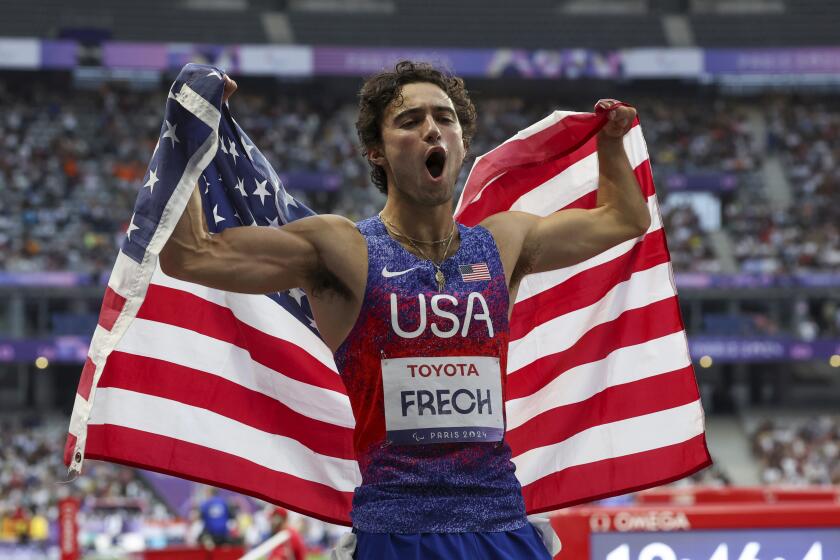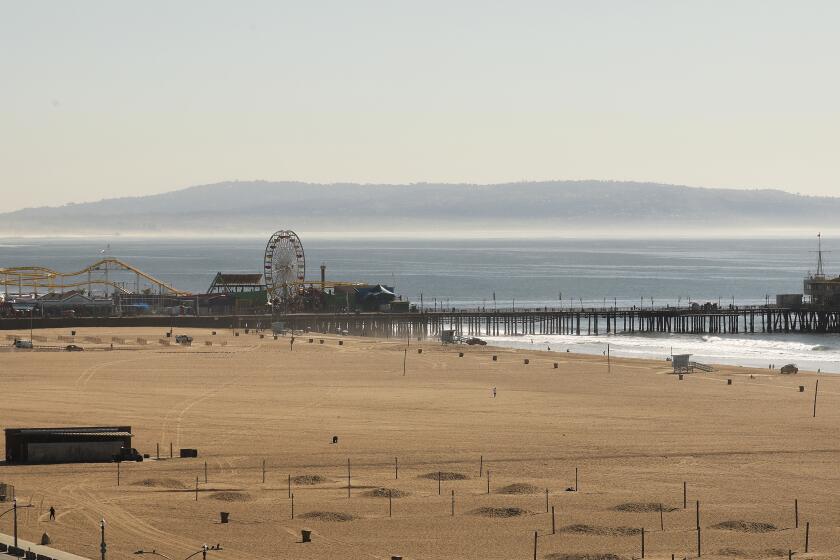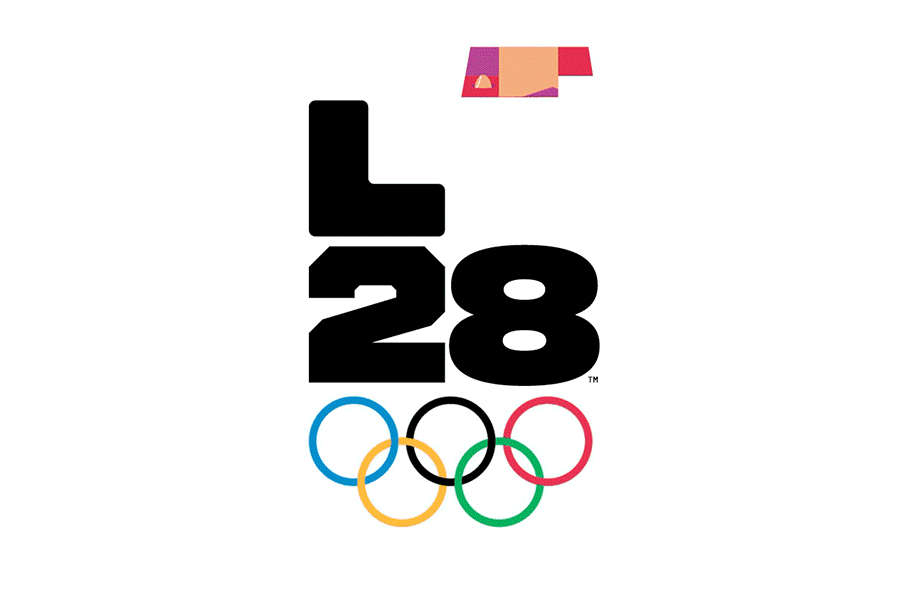Breaking Away
It begins as a murmur, traveling through the crowds at cycling races from Santa Barbara to Brea, from Lompoc to La Mirada, and builds, inevitably, to a crescendo.
Rahsaan’s here!
The men and women assembled, competitors and spectators, have noticed a racer riding a turquoise-and-blue bicycle and dressed in a stars-and-stripes jersey and American flag helmet. Amid athletes straining for advantage, the young man exudes a sort of anaerobic Zen.
His name is Rahsaan Bahati, and for cycling fans in Southern California, he is a home-grown hero. Bahati grew up in Compton, Carson and Crenshaw. He trained as a track racer at the Olympic Velodrome at Cal State Dominguez Hills, competed as a road racer for Major Motion, a cycling club based in Leimert Park, and now road-races for Mercury, an international team headquartered in Woodland Hills.
Most people have never heard of Bahati. Despite Lance Armstrong’s recent Tour de France victories, cycling has yet to garner the kind of rabid fan or media attention that it enjoys in Europe. But those who follow Bahati’s career believe he has the potential to change that. They suggest that he might represent the United States at the 2004 Olympics or be the first black rider in the Tour de France. Perhaps he can transform cycling in the same way that Tiger Woods reinvented golf as a sport for young people of all backgrounds.
There are, perhaps, 20 young American cyclists with similar skills and promise, but few inspire the same kind of passion or scrutiny. As Bahati has worked his way up through Southern California’s vast network of cycling races and teams, the color of his skin has made him instantly recognizable. Fans cheer him as if he were one of their oldest friends. Unknown cyclists track him down via cell phone, hoping to curry favor. Strangers act as if they know him and have a vested interest in his accomplishments.
The burden of such expectations can be extraordinary for a teenager, especially in a sport in which the odds of success are so slight. Only 1% of the more than 40 million Americans who ride bicycles recreationally race competitively, and only a hundred or so are good enough to earn more than a few thousand dollars a year from the sport. A mere dozen riders occupy the top echelon, and few have had to endure the glare of the spotlight that Bahati’s age, race and early success have brought.
At 19, Bahati is engaged in the mental and emotional Ping-Pong that is intrinsic to competition--and to growing up. One moment he is cocky, sure of his abilities; the next he is disenchanted, face to face with disappointment. He is trusting of others, and then suspicious of their motives. One day he seems to have the maturity of a 30-year-old; the next, he is sulky and listing excuses for a less-than-sterling performance. He is a work in progress, struggling to decide what he wants to be and how to get there. Like every young person, Rahsaan Bahati is learning to ride alone.
*
MORE THAN 100 CYCLING RACES ARE HELD IN SOUTHERN California each spring and summer, the first step in an evolutionary chain that can take a cyclist, if he or she is good enough, from regional beginnings to national calendar races and, eventually, prestigious European stage races such as the Tour de France and the Giro d’Italia.
At the local races, held most weekends on Southland streets, hundreds of cyclists hurtle by at speeds often topping 30 mph on sleek contraptions of titanium, carbon-fiber, aluminum and steel.
American road cycling includes two major types of races: true “road races,” usually 60- to 120-mile, three-to five-hour races on courses that wind up and down hills; and “criteriums,” shorter and faster (about an hour) races on tight, circular one- to two-mile flat courses. Competitors are a mix of amateurs and professionals who sacrifice most of their free time and cash to the sport. They train as many as 30 hours a week and travel almost every weekend between February and September to compete against other racers of like ability, gender and age. Although sponsors pick up some of the expenses for cycling clubs and teams--Armstrong’s is sponsored by the U.S. Postal Service--most cyclists finance their own racing careers. Their dedication and devotion to the sport has helped cycling become a $5-billion industry.
What they ride and wear are statements as well as weapons in pursuit of a prize. With a quick glance, cyclists can determine one another’s pedigree and prowess from the bikes they ride and their choice of components, accessories and clothing. Frames for the 18-speed racing bikes that most road racers prefer cost more than $1,000 each; add to that the price of parts such as derailleurs ($160), integrated shifters and brake levers ($250), crank sets ($210), wheels ($500), wheel forks ($200), brake calipers ($165), pedals ($135), saddles ($80), seat posts ($95), special cycling shoes ($200) and clothing ($150), and the cost of the sport skyrockets. (The wheels on Bahati’s racing bike, supplied by one of his team sponsors, would retail for $1,200.)
With these costs, plus charges for repairs, travel expenses and an average entry fee of $20 per race, a cyclist can easily spend a few thousand dollars a year on the sport--a price tag that limits participation and explains why cycling in the United States has long been the pursuit of the middle and upper classes.
Basketball, Bahati says, requires only “a couple [pairs of] shorts, and you can play. But cycling--there’s a lot of money involved.”
*
THOUGH BAHATI STILL WEARS BRACES AND HIS FACE STILL SHOWS SIGNS of teenage acne, he has the potential to be a compelling spokesman for his sport. He is poised and gracious and answers a reporter’s questions in small sound bites that often sound as if they have been rehearsed. Tall (over 6 feet), he is bike-racer slender, with a build that does little to hint at the strength of his fast-twitch muscles or their ability to spring into action and carry him through the last 300 meters of a sprint to the finish line with ease.
In the 2000 season, Bahati’s last year in “junior” (18 and under) competition, he announced his presence on the national racing scene with a remarkable series of victories. He won the junior national championships for both road and criterium racing as well as the Elite National Criterium Championship in Downers Grove, Ill., a race open to cyclists of all ages, becoming only the second junior ever to do so.
Because of his early achievements, Bahati was chosen for the U.S. junior national team and eventually for the U.S. Espoir team, a small group of 19-to-22-year-olds that USA Cycling, the sport’s national governing body, deems the future of American cycling. After graduating from Crenshaw High in 1999, Bahati put off college to race full time for Mercury and for USA Cycling’s national teams, which he has represented at races from Argentina to Belgium.
Bahati believes he can become the first African American cyclist to compete at the Olympics since Nelson Vails, a bike messenger-turned-racer from New York City, won a silver medal at the 1984 Los Angeles Games, when Bahati was 2. “I beat Tony Cruz [who was on the 2000 Olympic team] twice last year,” he reflects. “When I saw that, I was like . . . I could have made the Olympics.”
There’s a certain youthful bravado in his voice as he speaks, but there’s also a certain amount of hesitation as he allows himself this dream. This year has been a frustrating series of stops and starts, in which Bahati struggled with an early-season knee injury and friction with his team manager. This year has not lived up to the hype--and Bahati is acutely aware of that.
“Certain races I am having a hard time in. Maybe it’s because [before] there was less pressure on me, the competitors were more lenient on me. I still have the talent and the speed,” he says. “It’s just, things aren’t going my way. I don’t want to say it’s bad luck, but it’s just not my time yet.”
*
THE BAHATI HOME, WHERE RAHSAAN LIVES WITH HIS PARENTS AND four of his six siblings, sits on a quiet street just a few blocks off Crenshaw Boulevard. The house is a neat two-story with green trim, decorated with African art, family pictures and the spoils of Rahsaan’s victories. On top of the television is a golden cup--a trophy from the Tour de l’Abiti, a prestigious Canadian race for juniors. A carved stone, a trophy from the McLane Pacific Cycling Classic in Merced, stands in front of the fireplace.
Sitting on a couch in the living room, freshly showered after one of the five or six training rides he does every week, Bahati calls his ability to handle a bike “a gift” and marvels at his good fortune in how “everything has been working out with me and cycling.”
But the tale of Bahati’s ascension to this point is as much the story of how a community can take a child and make him a champion as it is about his natural affinity for the sport.
At 12, Rahsaan, a student at Davis Middle School in Compton, was getting into trouble--kid stuff, mostly, such as throwing rocks and goofing off in class. His mother, Nassoma, and his teachers, in an effort to fill up his after-school time, offered him a choice of activities: golf or biking. He chose the latter, thinking they meant motorcycles, and a few weeks later was enrolled in a course at the Dominguez Hills velodrome. When he first saw the banked track at the velodrome, he thought: “I can’t do this.” But within a few months, Bahati had begun competing with other boys his age, on bikes borrowed from the velodrome.
His coaches noticed his innate strength, how easily he could sprint around the track, and they encouraged his parents to buy him a track bike. But money was tight. Nassoma Bahati, who works at a continuation school for teenage mothers in Compton, and husband Rashid, then a high school teacher and now a new media producer, were supporting seven children, and spending money on a bicycle seemed extravagant. But Rashid Bahati bought a track bike anyway. “I think I paid four or five hundred dollars for a used track bike,” he recalls. “It was blowing me away, it costs this much, a used bike.”
By the end of the next year, Rahsaan Bahati had won a silver medal at the junior national track championships.
One day soon after Nassoma mentioned to some friends that her eldest son loved to ride and race bicycles; a woman in the group told her about a largely African American cycling club called Major Motion, based in Leimert Park. The club, Nassoma would learn, was named for Marshall “Major” Taylor, an African American cyclist who won his first of three consecutive world cycling championships in 1898 and became the first American to win the World Professional Cycling Championships.
A promise was made: Someone from Major Motion would be in touch with Nassoma Bahati. A few days later, she remembers, “They came over, met Rahsaan [and] took him under their wings.”
Travis Garrett, a club member, was to pick up Rahsaan each Saturday in Carson, where the family then lived, and drive him to Leimert Park for the weekly group training ride. That is where Bahati learned how to ride a bicycle on the open road. “When he started, he was a young kid with a lot of spunk, on a bike that was too small for him,” recalls David Pulliam, who coached Bahati as a junior and still runs the juniors program for Major Motion.
A member from Santa Barbara gave Bahati a road bike. The club watched him grow stronger. Garrett took him to his first road race, a criterium, in Long Beach. Bahati placed fourth. The next weekend, he raced again. He was hooked.
*
MAJOR MOTION MEMBERS CONTINUED TO GROOM BAHATI. THEY PAID his entry fees for races and accompanied him when his father or mother could not. “Every time racing came up, so did the issue of finances,” says Damon Turner, the current club president. “We stepped up to the plate and did what we had to do.” In 1997, when Bahati was 15, he went to his second national championships, in New Haven, Conn., representing Major Motion. The club raised $1,000 in a single night to send him. Bahati won another silver medal.
Few cyclists can boast the kind of support group that Bahati can. His parents, brother, five sisters, girlfriend and former teammates and coaches from Major Motion still cheer him on from the sidelines of races whenever and wherever possible. Major Motion’s members have become a sort of second family; Turner and Pulliam even helped Bahati pay for his senior prom.
“Rahsaan lives in the neighborhood; he stays close,” observes Pulliam. “That’s one thing that’s good about him. He doesn’t have an ego and helps the kids who come behind him.” Pulliam doesn’t think success will change Bahati, but he does suggest that the young cyclist has learned how to “play the game, manipulate the system a bit” to his advantage.
Indeed, Bahati works his cell phone like a seasoned business executive, fielding calls from the press, his agents and other cyclists at a dizzying pace. Bahati has two agents, one on each coast, who have taken him as a client on the promise of what will come--if and when the big money starts rolling in.
But that won’t be any time soon. While other 19-year-old athletes might be contemplating lucrative professional drafts, most cyclists at this age--including Bahati--are not ready to go pro. In cycling, “you can be on a farm team until you are 26,” says Danny Van Haute, a two-time Olympic team member and seven-time national champion who now coaches the U.S. junior team. “It’s not like you get out of college and sign a million-dollar contract.” The majority of senior and professional cyclists don’t peak until their late 20s. Armstrong, who started cycling after competing in triathlons as a teenager, won the Tour de France for the first time when he was 27.
“You just don’t go in overnight. It’s a hard transition,” says John Wordin, Bahati’s Mercury manager. “The kid is super-talented. If he makes it, it will be unbelievable for the sport. I think he can succeed if he can match his physical skills with a tough mentality, to go through the hardships. That’s what he needs to prove right now.”
Two years ago, Wordin’s team, sponsored by Mercury automobiles (and co-sponsored this year by Viatel, a European-based telecommunications company), was assembling what many considered the best junior team in the country. “As a junior, [Bahati] was winning senior local races, which showed he had some talent,” says Wordin. Bahati’s friends at Major Motion recognized that Mercury could provide Bahati the equipment and opportunities he needed to continue to hone his skills as a racer. They encouraged him to sign with Wordin with the bittersweet emotions of parents realizing that it is time to let a child leave the nest.
“We knew that it was coming,” says Pulliam. “We were happy that it was coming but also upset because we didn’t want to lose him. I don’t think he could have been as successful had he stayed with us locally. [Wordin] gave him the chance to go nationally. We couldn’t do that for him.”
Bahati continued his string of successes during the two years he raced for Mercury as a junior. But this year, after signing to race for Wordin for four more years, Bahati faltered--slipping in the U.S. rankings from 28th, where he was at the end of last season, to below 200--and his relationship with Mercury has become strained. At the same time, Mercury-Viatel lost a bid to compete in this year’s Tour de France, and Viatel filed for bankruptcy protection. “I am not the focus anymore,” he says of the team. “Before I signed my contract, they made it sound all good, but I signed it, and they know they got me and pretty much do whatever they want.” Bahati, who receives a $500-a-month stipend from the team for living expenses, complains that before the season began, Mercury promised “that they would help me, let me use an apartment in the Valley, where I could train really well, and there would be guidance. None of that has happened.”
Many of those in Bahati’s inner circle see Wordin as an interloper who has not supported Bahati the way they once did. Though they recognize that Mercury has provided Bahati with travel, opportunities and gear that they never would have been able to provide, they complain that Bahati has been sent to compete in mostly local, rather than national, races this year, without team members to support him. At many of his races in recent months, Bahati has been the lone competitor for Mercury, while most of his teammates have been at races in Europe or other parts of North America. In a sport in which competitors must rely upon their teammates to help them keep tempo and set up sprints to gain the lead or win a race, the lack of teammates is a distinct disadvantage. (He spent last month racing in the Midwest for Detrol L.A., a composite team, with Mercury’s blessing.)
Wordin, in turn, says that the team has sent Bahati to as many races as it could--but adds that when the team does send racers to specific national calendar races, it often is limited by race rules to sending the team’s 10 best riders or the riders on its team who are professionals. He suggests that Bahati’s support network is not giving him a realistic assessment of the work that must be done for him to compete at a professional level.
“Everyone expects him to be the great rider, and he has a great story, and he is a great kid, but people have to have realistic expectations,” he says. “People have to be patient. I try to be upfront with him, tell him it’s OK to struggle, we haven’t lost faith in you. I have been through this before.
“Hotshot juniors are a dime a dozen. Hotshot juniors who make it as pros, those are few and far between.”
To make the transition from junior to senior (and, eventually, professional) racing, a cyclist must do an extraordinary amount of conditioning to prepare his body for races that can be long, hard, hilly and fast all at once, often more than 100 miles and five hours long. He must turn his life over to the sport, training six and seven hours a day, spending long stretches of time far from home--often in Europe, which is seen as a training ground for young cyclists--and risking crippling injuries. It is grueling, solitary work, and the history of cycling in Southern California is littered with teenagers who crumbled under the strain of training and racing.
For a racer like Bahati, who so far has been able to rely upon his innate abilities to carry him through a racing season, the strain can be even more pronounced. “My eye caught him when he was 15 or 16,” says Van Haute, who coached Bahati for the U.S. junior team. “His bike-handling skills, his quickness, his ability to read a race, to win a race. You don’t see that at 15, 16. Rahsaan has a lot of natural talent. But even the talented people need to train.”
Roy Knickman, manager of Prime Alliance, a rival cycling team, who was an Olympic bronze medalist in cycling in 1984 and coached the U.S. national team in the mid-1990s, echoes this concern. “Rahsaan Bahati is probably the fastest, most gifted sprinter in the U.S. right now. But he is not a complete rider as far as his work capacity. If he were not really tired at the end of the race, he could beat anybody. But in the larger races he is normally too tired to utilize his speed--there’s not much in the tank.”
Bahati, who has had his best success as a criterium racer, on short, fast courses, admits that he needs to develop his endurance. That means long stretches of training so that he can build up his aerobic capacity and his ability to pedal for five or six hours at a stretch. He complains that it has been hard to train in Southern California, where his choice of rides has been hampered by L.A.’s geography and his lack of a car to take him beyond the city limits. But he disagrees that he is not training enough.
At this point in the season, he says, he trains by racing, and while he has won only a few races, he feels he is up to the challenges of the longest races. “I’m not following anybody’s [training] program. I am just doing what I want to do, and it is going pretty good. People gave me programs of what they think I should be doing, how many hours to train on this day, on that day. Now, if I am tired, and I don’t feel like riding, I don’t ride.”
Davis Phinney, the first American cyclist to win a Tour de France road race stage, who now runs a series of bike camps with his wife, former Olympic cyclist Connie Carpenter, has been following Bahati’s career since he saw him ride four years ago. He acknowledges that Bahati is at a crossroads and says that he has spoken with him, trying to help ease him through this period of transition. “When you win races, everyone wants to jump on board and offer you a lot of things. My advice to him is to define what his next greatest goal is.”
Will he remain a criterium king, master of the small local races, or will he move to the next, much more international level of competition? “I would love to see Rahsaan as a Tour de France winner or a world champion, and he has that possibility, but there are always people with possibility. He has to differentiate himself. Just like Lance does. The hardest part of growing up in sport is being able to make the right decisions.”
Bahati listens to the advice of those around him, trying to figure out what works best for him. “In a way,” he admits, “I wish certain things can happen overnight, but I know they can’t. I am just now learning that it ain’t gonna happen overnight.”
Eventually, he acknowledges, “if I keep doing this, it’s going to become work, it’s going to become a job. But I still want to have fun. I don’t want to go to a race and just train and sleep and ride.”
Bahati’s next move seems to indicate that he is trying to find a balance in his life, or at least a backup plan. He will attend Indiana University at Bloomington (home of the “Little 500,” the cycling race captured in the movie “Breaking Away”) on scholarship starting this month. He wants to study computer animation or sports medicine--the latter because he wants to be involved in the sport regardless of whether he is racing.
Bahati will continue to train while at Indiana (“I can just ride” there, he says. “Here, I see the same thing, stoplights, over and over. It gets boring. A change would be nice.”) and plans to race on weekends and vacations. If all goes well, he will emerge from his four years in Indiana with a degree at the age when most cyclists are only beginning to blossom, with a better perspective of the world and all his options. But few professional cyclists have been able to juggle school and the all-consuming sport; if Bahati has difficulty doing so, it may force him to decide whether cycling is his highest priority.
“The big question,” says Knickman, “is whether or not he is motivated and sees cycling as a future he wants. Cycling has become very difficult. The demands are rigorous.”
Van Haute, for one, thinks Bahati will choose cycling. “I think he wants it,” he says. “I guarantee you that he wants it. I will bet $100 on the fact that he will be one of your top-notch pros in three years. But it’s going to take that long. And I think he’s starting to realize that.”
More to Read
Go beyond the scoreboard
Get the latest on L.A.'s teams in the daily Sports Report newsletter.
You may occasionally receive promotional content from the Los Angeles Times.
